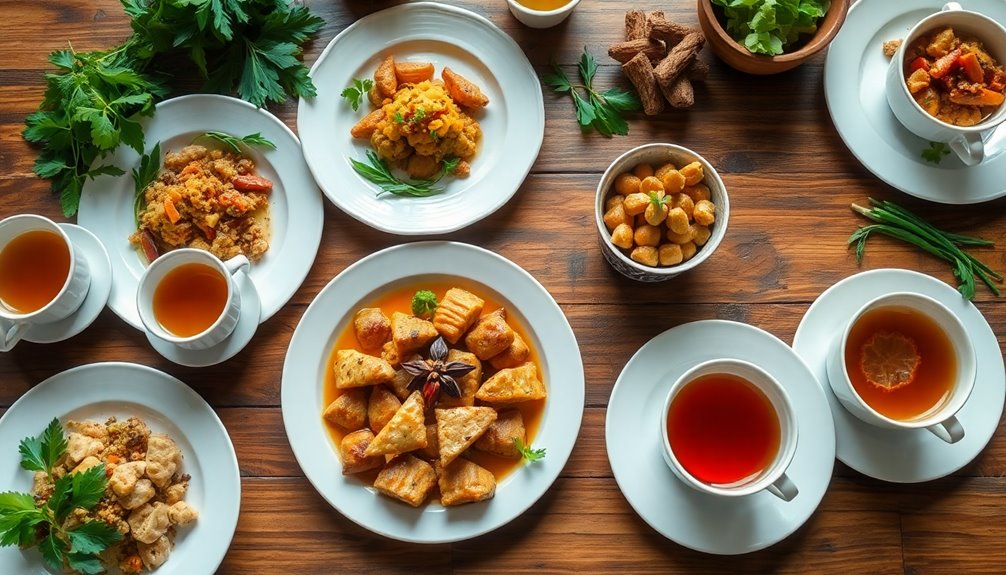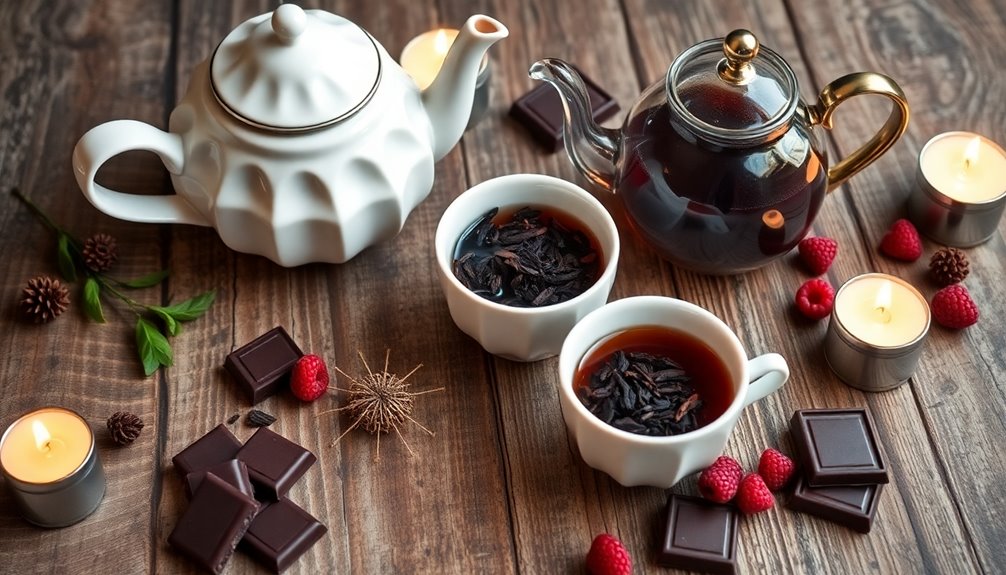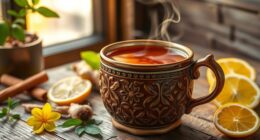Discovering the art of pairing tea with cheese can transform your culinary experiences. Start by matching intensity—creamy brie shines with bold black tea, while tangy goat cheese dances with floral green teas. Experiment with seasonal pairings, like nutty gouda with earthy oolongs in the fall. Don't shy away from contrasting flavors; salty cheeses often pair beautifully with sweeter teas. Engaging in tastings allows you to explore and document your favorite combinations. Each pairing can unveil new dimensions of flavor and enjoyment, enhancing your appreciation for both tea and cheese as you explore further.
Key Takeaways
- Balance the intensity of tea and cheese for an enjoyable pairing experience, considering the flavors of each.
- Creamy cheeses, like brie, complement bold black teas, while lighter cheeses pair well with fragrant green teas.
- Explore cultural traditions, as different regions feature unique cheese and tea combinations that enhance flavors.
- Experiment with contrasting flavors, such as salty cheeses with sweet teas, to inspire creative pairings.
- Host tasting events to discover and document your favorite cheese and tea combinations, enhancing your culinary journey.
Introduction
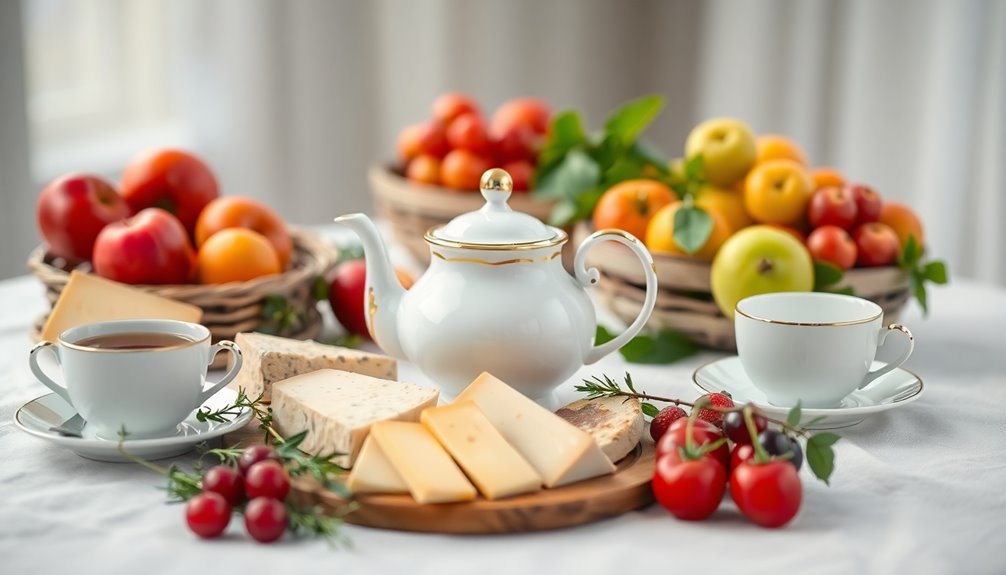
When it comes to enjoying flavors, many find that pairing tea with cheese creates a unique and delightful experience. This art form brings together two culinary worlds, allowing you to explore an array of flavor profiles.
The key to successful pairing lies in understanding how different teas and cheeses complement each other. For instance, creamy cheeses like brie enhance the rich, robust notes of bold black tea, while lighter options, such as goat cheese, harmonize beautifully with fragrant green tea that offers floral notes.
You'll want to consider the intensity of both the tea and cheese. Strong-flavored cheeses can stand up to robust teas, creating a balanced tasting experience. On the other hand, milder cheeses should be paired with delicate teas to highlight their subtle qualities.
Experimentation is essential, so don't hesitate to try unexpected combinations. Seasonal pairings can also elevate your experience—think fresh goat cheese with jasmine green tea in spring or a rich cheddar with an earthy oolong.
Cultural Tea and Cheese Traditions
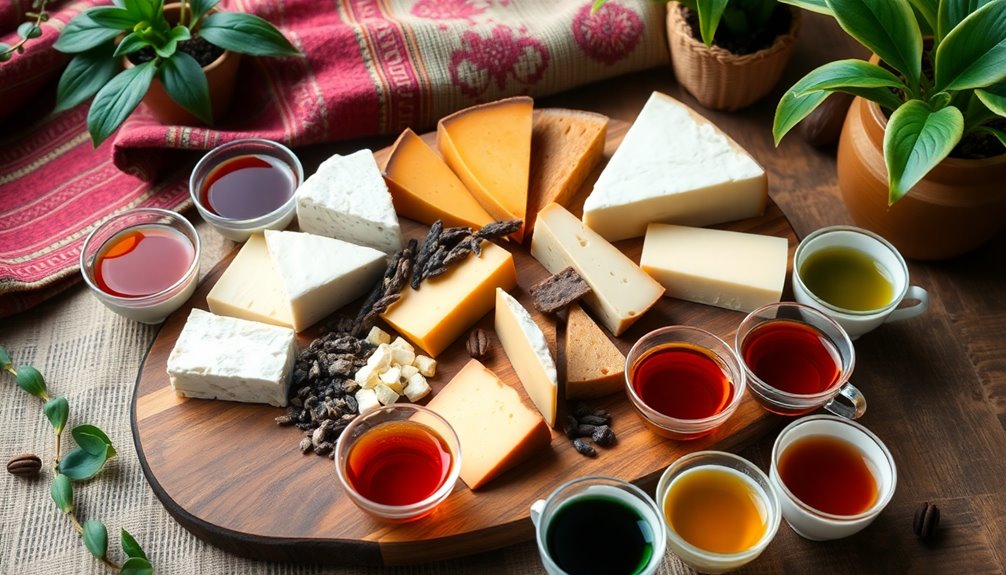
Throughout history, cultures around the world have developed unique traditions that celebrate the delightful pairing of tea and cheese. In French cuisine, you'll find creamy cheeses like Brie often paired with floral teas such as jasmine. This combination enhances the delicate flavors of both, creating a harmonious experience. The art of traditional tea ceremony emphasizes the importance of mindfulness, which can elevate the enjoyment of such pairings and foster emotional resilience in the process. Additionally, many cultures believe that astrology and attractiveness can influence preferences for certain flavor combinations, further enriching the experience.
Italian culture, on the other hand, features aged cheeses like Parmesan, which goes well with spiced black teas. This pairing balances the nutty notes of the cheese with the warmth and complexity of the tea.
In India, chai is commonly enjoyed with paneer, utilizing the rich, spiced flavors of the tea to complement the mildness of the cheese.
If you find yourself in the UK, traditional afternoon tea offers savory cheese scones alongside light floral teas, making for a delightful blend.
These cultural traditions celebrate regional ingredients, showcasing how local cheeses and teas can create unique flavor combinations. Whether you're savoring goat cheese with a robust tea or indulging in a creamy Brie, you'll discover that pairing tea with cheese isn't just a culinary delight, but also a beautiful reflection of cultural heritage. Engaging in these pairings can also foster collaboration and teamwork through shared culinary experiences, similar to the benefits of STEM education.
Flavor Profiles Enhance Pairing
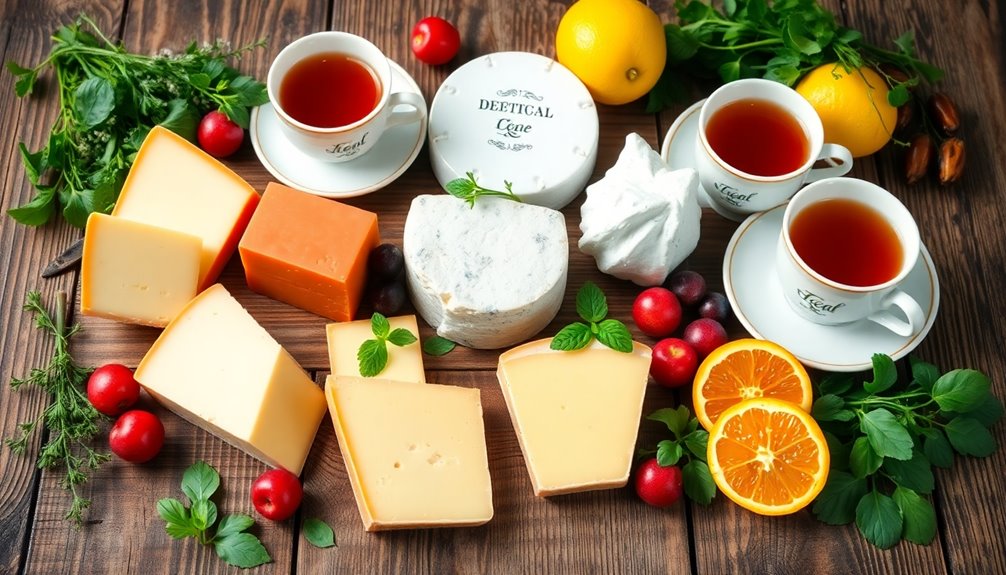
Understanding flavor profiles is key to mastering the art of pairing tea with cheese. When you explore the complex tastes of tea and cheese, you'll find that cheese can exhibit sweet, salty, sour, and bitter notes, while teas offer floral, earthy, and spicy flavors.
For instance, pairing creamy cheeses with black teas high in tannins can create a perfect balance, as the creaminess tames the astringency, allowing both elements to shine. Additionally, incorporating nutrient-dense options like chia seeds into your diet can enhance your overall tasting experience, as they provide sustained energy for enjoying such pairings. Understanding the importance of transaction fees in e-commerce can also help you budget for gourmet cheese and specialty teas. The right tea accessories can further elevate your enjoyment by providing the perfect brewing tools. It's also beneficial to consider market volatility when selecting gourmet options, as prices can fluctuate significantly.
If you're working with blue cheeses that possess strong flavors, opt for robust green teas or herbal teas to enhance the experience without overwhelming your palate.
Salty cheeses, on the other hand, harmonize beautifully with sweeter teas, enhancing the saltiness and creating an enjoyable contrast. Additionally, exploring essential oil benefits can elevate your pairing experience by adding aromatic elements that complement both the tea and cheese.
Tea and Cheese Regional Variations
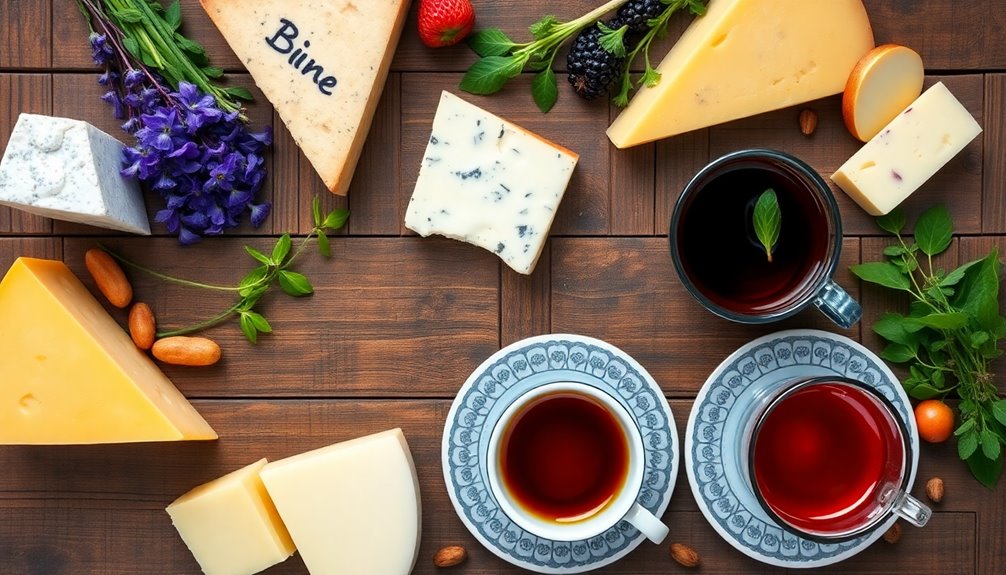
Have you ever considered how regional traditions influence the pairing of tea and cheese? In France, you'll find that creamy brie or camembert pairs beautifully with floral teas like jasmine or rose. This combination highlights the cheese's texture and delicate flavors. Additionally, the economic benefits of supporting local cheese and tea producers can enhance your culinary experience. The importance of sustainable practices in both tea cultivation and cheese production also plays a role in these pairings. Furthermore, many raw food enthusiasts believe that incorporating raw foods into your diet can complement these pairings by enhancing overall health. Chia seeds, known for their high fiber content, can also contribute to digestive health when included in a balanced diet.
Meanwhile, in Italy, the nutty and savory notes of parmesan go well with spiced black tea, where the tea's warmth enhances the flavors.
In India, chai—a rich, aromatic spiced tea made from Assam leaves—traditionally accompanies paneer, balancing the cheese's mildness with its robust spices.
Spanish cuisine offers another delightful pairing, as herbal tea like chamomile complements the nutty flavors of manchego cheese with its floral notes.
If you venture to Switzerland, you'll discover that robust black teas are perfect for enjoying with raclette cheese. The strong flavors of the tea can stand up to the intense, melted experience of the cheese, creating a satisfying balance.
These regional variations show how local tastes shape your experience when you pair tea and cheese, enhancing flavors in delightful ways. Additionally, the growing interest in sustainable tea production reflects consumers' desire for quality and ethical sourcing, which can also influence pairing choices.
Pairing Preferences and Misconceptions
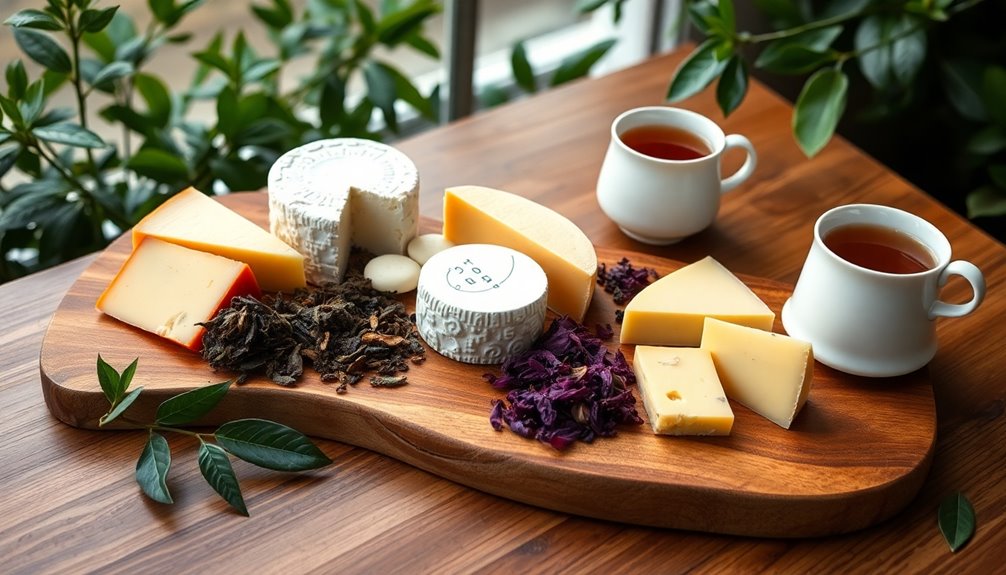
Pairing tea with cheese can be a delightful adventure, yet many people hold misconceptions that limit their enjoyment. For instance, some assume that tea pairings must follow the same guidelines as wine, but tea's unique flavor profiles require a different approach. Additionally, many teas contain antioxidants that combat oxidative stress, which can enhance the overall tasting experience. Antioxidants can also support overall health, making the pairing even more enjoyable. It's important to note that just as with food, certain safe ingredients can enhance the flavor profiles of both tea and cheese.
You might think only certain cheeses, like blue cheese or goat cheese, can go with tea, but that's far from true. In reality, a variety of cheeses, including soft and creamy options, can complement various teas. Moreover, exploring essential oil blends for relaxation can add an aromatic touch that elevates the pairing experience.
Another common belief is that strong cheeses should only be paired with robust teas. However, lighter teas can balance and enhance the flavors of stronger cheeses when chosen thoughtfully.
Herbal teas often get overlooked due to their perceived diversity, but many blends harmonize beautifully with specific cheese types, especially those with complementary flavor profiles. Additionally, certain antioxidants present in teas can further enhance the pairing experience, creating a delightful balance with the rich flavors of cheese.
Practical Applications

When exploring the world of tea and cheese, you'll find that practical applications can elevate your tasting experience significantly.
Start by visiting your local cheese shop, where you can discover different types of cheese that pair well with various teas. For instance, creamy cheeses like brie complement bold black teas beautifully, while tangy goat cheese shines when paired with delicate floral green teas. Juices like pomegranate juice can also enhance your skin health, making you look radiant while you enjoy your tasting. Additionally, certain herbal teas can provide unique flavor notes that enhance the cheese selection, similar to how different cheese types can influence the overall experience.
Consider the texture of the cheese as you make your selections. Strong aged cheeses, such as aged gouda, should be matched with robust teas to enhance their flavor. Conversely, delicate cheeses fare better with light-bodied teas to avoid overpowering their subtlety.
Seasonal pairings can also enhance your tasting experience. For example, nutty gouda with earthy oolong teas makes a perfect fall pairing, while tangy cheddar with fruity iced black teas is refreshing for summer.
Don't shy away from experimenting with contrasting flavors; salty cheeses can work surprisingly well with sweet teas. Additionally, pairing teas with herbal teas for fibromyalgia may provide a relaxing element to your tasting experience, enhancing overall comfort.
Hosting a tasting event is another fantastic way to explore these combinations. Start with milder cheeses and teas, gradually progressing to stronger options for a curated experience that highlights the unique characteristics of both.
Conclusion
Now that you've explored the delightful world of tea and cheese pairings, it's time to get creative! Experiment with different flavor profiles and discover your personal favorites. Don't be afraid to break traditional rules—your palate is the ultimate guide. Whether you're hosting a gathering or enjoying a quiet moment, pairing these two timeless elements can elevate your experience. So, grab your favorite tea and cheese, and start savoring the delicious combinations waiting for you!



